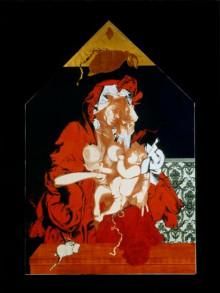
From the Heroines Collection: Helen Chadwick One Flesh, 2003 © The Helen Chadwick Estate
Helen Chadwick (1953 – 1996)
British photographer
Helen Chadwick (18th May 1953 – 15th March 1996) was a British photographer, sculptor, and installation artist. Helen’s work became internationally renowned following her nomination for the Turner Prize in 1987; one of the twentieth century’s leading women in photography, she was one of the first women photographers to be nominated for the award.
Born in Croydon, Helen embarked on a Fine Art Foundation course at Croydon College after leaving secondary school and went on to study at Brighton Polytechnic, now University of Brighton (1973–76). Her work from this period demonstrates how thematic preoccupation with the body, as well as audience interactivity, were crucial to Helen from the inception of her practice.
Helen consistently presented skilful, vehement challenges to stereotypes surrounding the body. Created using a cornucopia of source materials including chocolate, lambs tongues cast in bronze, and rotting vegetables, her art possesses a uniquely visceral quality. Ian Potts, a former tutor, recalls, ‘Her works were very experimental but she was in charge of the experiments’.
Helen’s first major solo exhibition, Of Mutability, opened in 1986 at the ICA. It was described by Marina Warner as ‘a post-lapsarian Paradise where woman is visible alone among humankind […] we are introduced into a cycle of experiences, mediated through an imaginary body composed from the artist’s own, from photocopies in collage’.
Beginning to use a photocopier to create her installations after becoming frustrated with having to use an assistant to photograph her own body, Helen integrated images of both herself, and posed dead animals, into the work. According to artist Cathy de Monchaux, Helen’s show was so instrumental in forming the trajectory of the art which followed that ‘it should be given a clear place in the history of art’ in the UK.
Binary opposition is central to Helen’s art; her work conveys the interrelation between seductive/repulsive, male/female, organic/man-made. Helen invoked these apparent oppositions in order to critique them, particularly the gender binary. In a 1991 lecture, she referred to ‘dual structures in language’ which are defined as ‘oppositional’, such as male / female and mind / body, as ‘problematic’ and ‘absurd’.
Concluding that painting and other traditional media were still ‘the domain of men’, Helen pioneered the invention of radical new artforms. Her work went on to inspire a generation of emerging artists, in particular the Young British Artists – many of whom studied at Goldsmiths, London, during the 1980s while Helen was tutoring there.
The YBA’s work is marked by principles to which Helen also adhered – ‘a complete openness towards the materials and processes with which art can be made, and the form that it can take.’
By Katherine Riley











